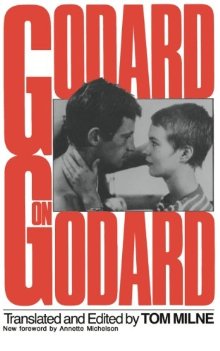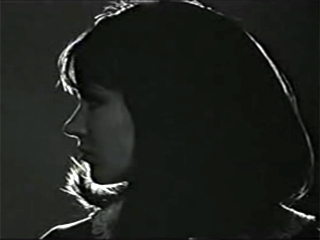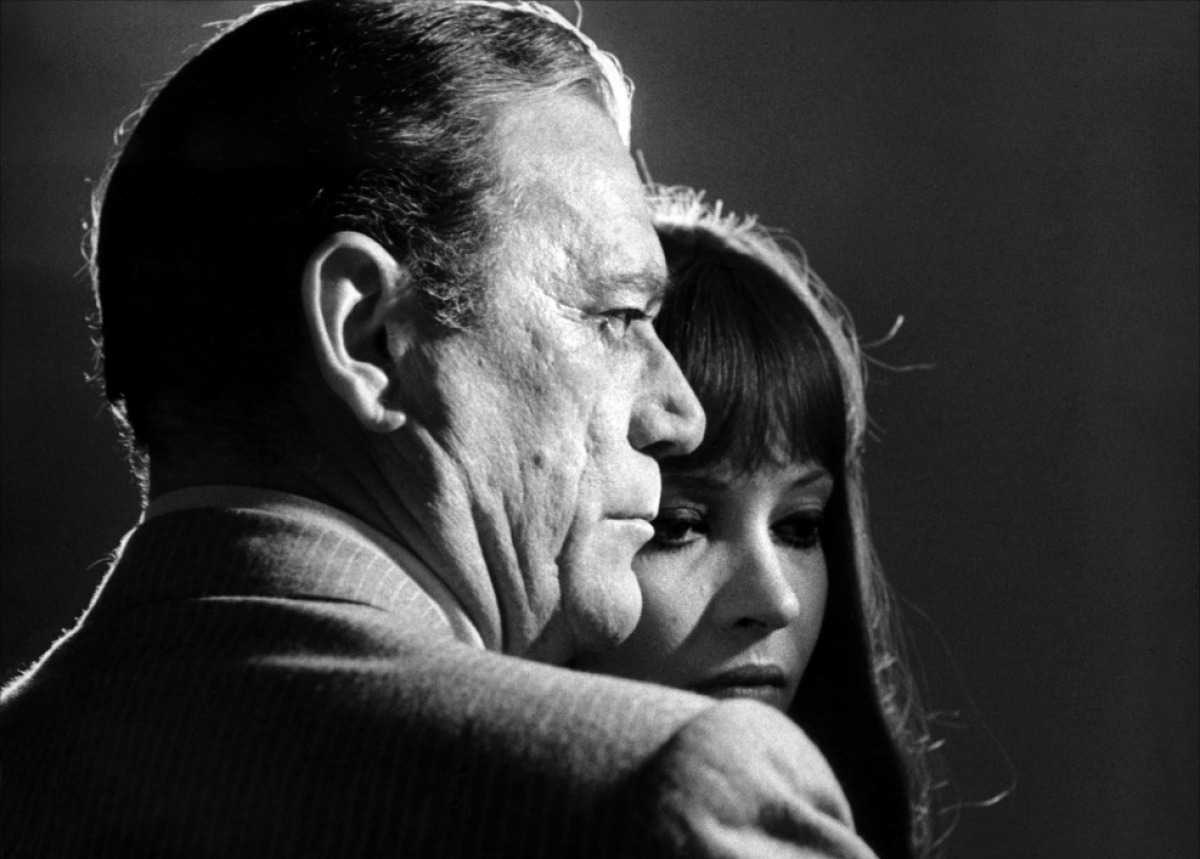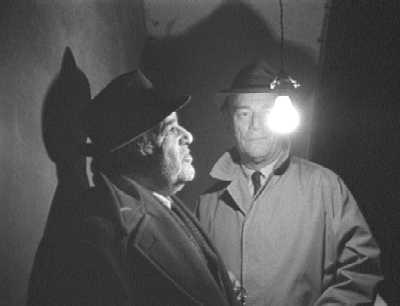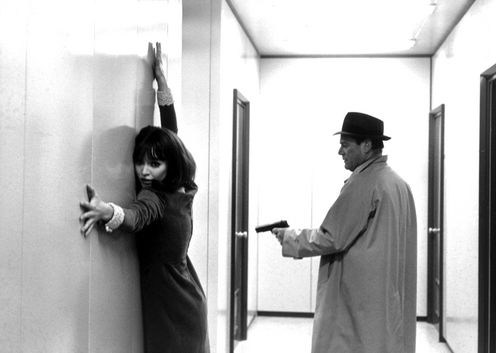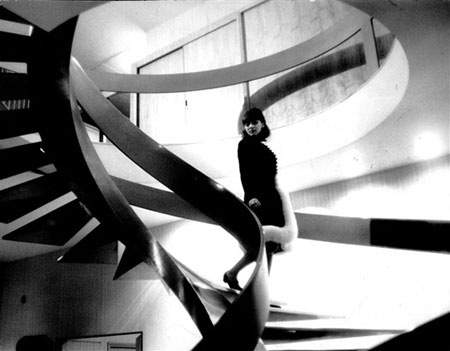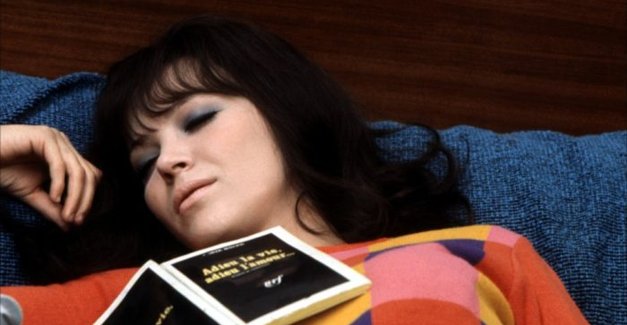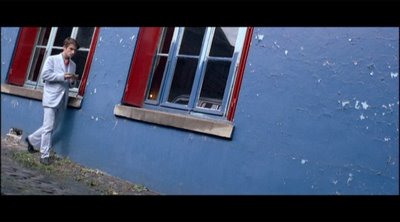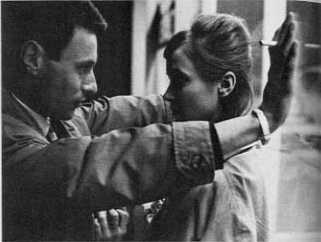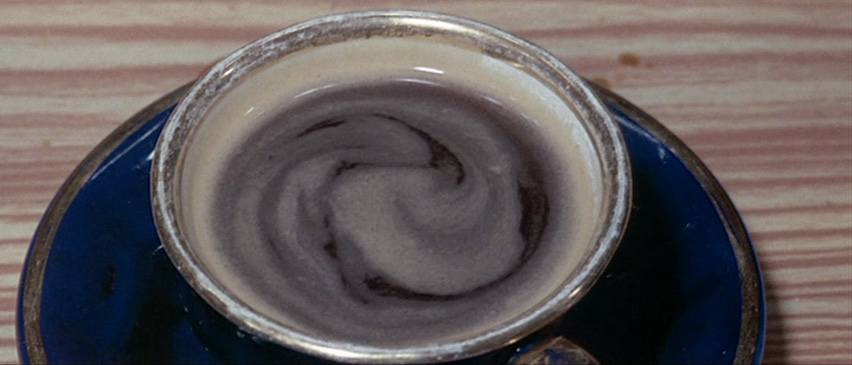From the Summer 1972 issue of Sight and Sound. This was my first contribution to that magazine. — J.R.
Godard’s collected criticism (1) is many things at once: informal history (1950–1967) of the arts in general and film in particular, spiritual and intellectual autobiography, a theory of aesthetics, a grab bag of puns. For those who read the pieces when they first appeared — chiefly in the yellow-covered Cahiers du Cinéma and the newspaper format of Arts — it was frequently ill-mannered gibberish that began to be vindicated (or amplified) when the films followed, retrospectively becoming a form of prophecy:
Each shot of MAN OF THE WEST gives one the impression that Anthony Mann is reinventing the Western, exactly as Matisse’s portraits reinvent the features of Piero della Francesca . . . in other words, he both shows and demonstrates, innovates and copies, criticizes and creates.
For those who encounter the films first, it is likely to seem like an anthology of footnotes serving to decipher and augment what may have once seemed like ill-mannered gibberish on the screen. But for those more interested in continuity than cause and effect, it rounds out a seventeen-year body of work — from an article on Joseph Mankiewicz in Gazette du Cinéma to the “Fin du Cinéma” title concluding WEEKEND — that has already transformed much of the vocabulary and syntax of modern narrative film, further illustrating a style that has passed from avant-garde to neoclassical in less than a decade. And as a fringe benefit, for those interested in Getting Ahead in the Commercial Avant-Garde, it is probably the best casual guidebook since Francis Steegmuller’s recent biography of Cocteau.
Like Cocteau, Godard commands a vigorous rhetoric that crosses nimbly from one medium to another, registers most effectively in aphorisms, playfully orbits the work of other artists into a toylike cosmology of its own, and instantly changes whatever it touches by assimilating it into a personal aesthetic. Look long enough at his criticism and virtually every departure in Godard’s films will be theoretically justified; study the films with enough scrutiny, and even the most outrageous reviews will start to make sense.
Generally less pugnacious than Truffaut, less logical than Rivette, and less Catholic than either Chabrol or Rohmer, Godard tops all four as a critic on the few occasions when he works at full steam. In “Defence and Illustration of Classical Construction” (a brilliant riposte to Bazin’s antimontage theoties), “Take Your Own Tours” (a mosaic of travelogue, festival reporting, and aesthetics), and reviews of THE WRONG MAN, A TIME TO LOVE AND A TIME TO DIE , and MAN OF THE WEST, he displays a rigor, imagination, and feeling for nuance that few other critics of the period have equaled. In the least interesting pieces — mainly volleys of dull spite against films that usually don’t warrant the effort — he becomes a semi-anonymous journalist typing out his obligatory notice. Some articles, such as the one on Mizoguchi, seem to be paste-ups of remembered conversations with colleagues; others are unabashed advertisements for the films of friends; while a few (notably reviews of BITTER VICTORY and MONTPARNASSE 19) forsake critical decorum altogether, take off into the clouds, and deliver impassioned dithyrambs to the gods who inspired the ascent — moving and daring declarations even when one is less than clear about the precise meanings:
MONTPARNASSE 19 is a film of fear. In this sense, it might be subtitled “the mystery of the film-maker.” For in unwittingly investing Modigliani’s unbalanced mind with his own perturbation, Jacques Becker — clumsily, admittedly, but infinitely movingly —allows us to penetrate the secret of artistic creation more effectively than Clouzot did by filming Picasso at work. After all, if a modern novel is fear of the blank page, a modern painting fear of the empty canvas, and modern sculpture fear of the stone, a modern film has the right to be fear of the camera, fear of the actors, fear of the dialogue, fear of the montage. I would give the whole of post-war French cinema for that one shot, badly acted, badly composed, but sublime, in which Modigliani asks five francs for his drawings on the terrace of the Coupole.
Then, but only then, everything pleases in this displeasing film. Everything rings true in this totally false film. Everything is illuminated in this obscure film. For he who leaps into the void owes no explanations to those who watch.
The spirited, nonstop babble of this voice, heard the same year (1958) dubbing Jean-Paul Belmondo in CHARLOTTE ET SON JULES, is a guttural, rasping monotone that somehow manages to traverse enormous distances quickly; using epigrams as stepping stones, it proceeds by leaps and bounds across vast reaches of contemporary culture. Perhaps the most distinguishing feature of this style is impatience. Consider Truffaut’s memories of Godard around 1950:
What struck me most . . . at the time was the way he absorbed books. If he were at a friend’s house, during one evening he would open easily forty books, and he always read the first and last pages. . . .
He liked cinema as well as any of us, but he was capable of going to see fifteen minutes each of five different films in the same afternoon.
This frenzied rush — a race with destiny, like Belmondo’s attempted flight at the end of BREATHLESS — appears to be the impetus behind most of the achievements, from the jump cuts of the early films to the extended, autonomous takes of the later ones. At the point of self-parody, it is “Bouvard and Pecuchet” in a cafe in 2 OR 3 THINGS I KNOW ABOUT HER, speedily reciting and copying down random passages from a mountain of books. In Godard’s prose as much as in his films, this sense of urgency creates a form of criticism in the present tense, an endeavor that no other recent critic — with the possible exception of Manny Farber — has even approximated. It is essential to this method that everything remains in process: ideas are introduced in order to spawn other ideas rather than flesh out careful exegeses, and movement invariably takes precedence over explanation: “There was theatre (Griffith), poetry (Murnau), painting (Rossellini), dance (Eisenstein), music (Renoir). Henceforth there is cinema. And the cinema is Nicholas Ray.” In a footnote to the first sentence, Godard spends three paragraphs trying to explain away all his paradoxes; but each argument becomes still another leap into the void.
The continuities between Godard’s reviews and other films he has seen, and still others which he will eventually make, create a dense network. DERRIÈRE LE MIROIR, the French title of Ray’s BIGGER THAN LIFE, crops up frequently as an image in reviews that presumably have nothing to do with Ray.
A line delivered by Mai-Britt Nilsson in Bergman’s SOMMARLEK — about not being able to close her eyes as tightly as she wants to — fails to appear in Godard’s tribute to the film in “Bergmanorama,” but surfaces nine months later in his review of A TIME TO LOVE AND A TIME TO DIE, where he uses it to define the theme of Sirk’s film (“blackness”) without mentioning either Bergman or the film’s title; shortly thereafter, Jean Seberg delivers the line in BREATHLESS. Four years later, Sirk’s film in its turn becomes an important source for LES CARABINIERS — particularly the shooting of a partisan woman who denounces her assassins (a Russian peasant in Sirk’s film, a French girl quoting Mayakovsky in Godard’s). Another variation of the scene appears at the indoor swimming pool in ALPHAVILLE . . . but why go on? Undoubtedly hundreds of such threads could be traced through Godard’s labyrinth.

***
By his own admission, Godard’s films are also criticism, and it is worth considering how — and how effectively — they fulfill this function. Blake’s “Imitation is criticism” is not quite enough; indeed, Eliot’s “Between the emotion / And the response / Falls the Shadow” probably comes closer to explaining Godard’s distance from his models. BREATHLESS works intermittently as a thriller, but self-consciousness about the genre tends to veer it in another direction; BANDE À PART — like Monicelli’s BIG DEAL ON MADONNA STREET — mainly comments on other “big heist” films by failing to match them. Just as Faulkner, by his own account, developed his prose style out of an inability to write lyric poetry, Godard’s modernism — at least until PIERROT LE FOU — largely stems from his inability to make pure “classic” or genre films. (After that, one would probably have to substitute “refusal” for “inability.”) And it is in the shadow between emotion and response, model and imitation, that his criticism must be located.
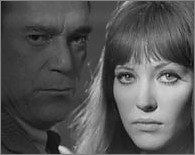
In ALPHAVILLE, this shadow is blackness — specifically, the blackness of the German expressionist cinema (CALIGARI and PANDORA’S BOX, MABUSE and METROPOLIS, THE GOLEM and FAUST) and the cinema that derives from it (SCARFACE and KISS ME DEADLY, ORPHÉE and THE TRIAL). Perhaps the two latter films, in addition to furnishing the Orpheus myth and Akim Tamiroff, also suggested the use of real locations instead of sets. But by relating this use to science fiction (which itself has important links with German expressionism), Godard criticizes the conventions of the genre — and subsequently alters its possibilities, to judge from offspring like THX 1138. More profoundly, he comments on the implicit thematic values of light and darkness in German expressionism by making them explicit, even self-conscious, in the film’s symbology. “Light that goes . . . light that returns,” chants Natasha in the film’s central love scene, as the light modulates back and forth from blinding intensity to darkness — as it does throughout much of the film, usually at a faster, blinking tempo. “From needing to know, I watched the night create the day . . . ” “What transforms the night into day?” Alpha-60 asks Lemmy, who replies: “Poetry.” Even the abrupt shifts to negative express the same dialectic. (2) Quite aside from the specific homages (figures clinging to the wall like Cesare sleep-walking in CALIGARI, a track through the hotel’s revolving door from THE LAST LAUGH, Professor Nosferatu, etc.), ALPHAVILLE has more to say about the silent German cinema than any of the passing references in Godard’s essays. Criticism composed in the language of the medium, it brings social and aesthetic insight equally into focus, and certainly deserves a place next to Kracauer and Eisner.
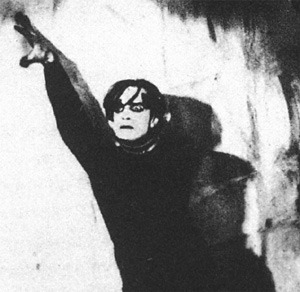
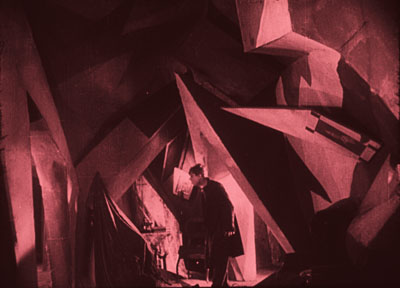
The relative cohesiveness of ALPHAVILLE ‘s imagery gives it a steadier critical reference than most of Godard’s other films: perhaps only LES CARABINIERS, his critique of the war film, sticks as closely to its subject. More frequently, he comments on genres by mixing them, or playing one off against the other. PIERROT LE FOU is largely a colorful fruit salad of Hollywood forms — crime thriller, comedy, chase film, musical, adventure. In UNE FEMME EST UNE FEMME, neorealism can’t do justice to the dreams of Angela, and musical comedy would gloss over the drabness of her days, so Godard attempts a “neorealist musical” to paint her life. Unfortunately, the drabness is itself pretty banal, the comedy laborious, and Michel Legrand’s musical score — neither synchronized nor asynchronized with the action in a convincing manner — consistently unmemorable. The net result is fairly constant clumsiness, in nearly every department, and in order to justify this film — as criticism or art — one would ultimately have to evoke Godard’s review of MONTPARNASSE 19 as a support (as Jean-André Fieschi once did in Cahiers).

In MADE IN U.S.A., however — one of the most maligned films in Godard’s pre-1968 canon, and undeservedly so — the crossbreeding of the violent action thriller with the animated cartoon yields much more interesting results. Confronting a web of impenetrable, anxiety-producing mysteries (the Kennedy assassination, the Ben Barka affair, etc.), Godard chooses — much like Rivette in PARIS NOUS APPARTIENT — to evoke their terrors by making his intrigue as ambiguous and complex as possible. Turning to seemingly incompatible Hollywood genres for illustration, he begins to suggest what the two have in common: tendencies toward sadism and hysteria, idealization of types with occasional right-wing implications; the wish-fulfillment and fantasy of the crime thriller, the primal violence and terror of the cartoon. (To exemplify these strains in two recent releases, consider Disney’s SONG OF THE SOUTH and Siegel’s DIRTY HARRY.) The aggressive antilogic of various elements in the dialogue and plot helps to abstract these genres, for Godard’s purposes, into simplified, almost schematic formal diagrams: lots of red paint and brutal noises, rapid transitions, and dreamlike ellipses. This pungent blend of sensual and compositional “essences” recaptures some of the spirit of both genres while revealing their formal and political meeting points. Numerous annotations are offered on the subject: “a film by Walt Disney, but played by Humphrey Bogart,” “Walt Disney plus blood”; a dedication of the film to Nick (Ray) and Samuel (Fuller) in bold primary colors; characters named David Goodis, Inspector Aldrich, Mark Dixon, Dr. Korvo (3), and Widmark, the last of whom (Laszlo Szabo) imitates Tweety Pie; a black car parked in front of a Disney display. Unlike ALPHAVILLE , this cannot be called criticism in depth; but it is provocative commentary nonetheless.
***
Although WEEKEND, the last of Godard’s features to be completed before May 1968, probably contains more filmic allusion per square foot than any that preceded it, the direction of his criticism from MASCULINE-FEMININE (1966) increasingly turns from cinematic to social and political subjects. Not that an interest wasn’t already there: his second published essay, dated 1950, is entitled “Toward a Political Cinema.” But judging from his subsequent prose, it probably isn’t until “Take Your Own Tours” nine years later that the world outside the cinema begins to become more important than the movies inside. And even in LE PETIT SOLDAT, an attempt to confront the Algerian war, Godard’s sources are politics in literature and cinema rather than in the street. The tempo, duration, and dry, objective treatment of Bruno’s extended torture and suicide attempt seem partially derived from Dashiell Hammett’s The Glass Key (which already supplied BREATHLESS with a wisecrack about wearing silk and tweeds together). Moreover, the existential decision of Hammett’s hero to submit to brutality rather than betray his friend, a corrupt politician — essentially resolving to stick by one crook instead of another — closely parallels the moral arbitrariness of Bruno’s choice of Right over Left, which leads to his own torture at the hands of the FLN. Within each scale of values, taking a position and remaining steadfast seems more of an issue than the actual position taken.
According to Jean Collet, in his book Jean-Luc Godard, Godard’s “point of departure” for LE PETIT SOLDAT was the character of O’Hara in THE LADY FROM SHANGHAI. Bruno’s final words in the film do have a somewhat familiar ring: “Only one thing was left to me: learn not to be bitter. But I was happy, because I had a lot of time in front of me.” And the following comparison of dialogue from JOHNNY GUITAR and LE PETIT SOLDAT speaks for itself, further suggesting that the doomed romanticism of Hammett, Welles, and Ray appealed more to Godard at the time than the social and political questions they dealt with:
Johnny (Sterling Hayden): Lie to me, tell me that all these years you’ve waited for me, tell me.
Vienna (Joan Crawford): All these years I’ve waited for you.
Johnny : If I hadn’t returned, you would have died.
Vienna : If you hadn’t returned, I would have died.
Bruno (Michel Subor): Lie to me . . . Say you aren’t sad that I’m leaving.
Véronica (Anna Karina): I’m not sad that you’re leaving. I’m not in love with you. I won’t join you in Brazil. I don’t kiss you tenderly.
When Godard cast Jean Seberg as a journalist in BREATHLESS, this may have been prompted by his own immediate past, which had at least as much to do with journalism as with criticism. When he recast her as a television reporter in LE GRAND ESCROC, changing her name from Franchini to Leacock, he was resuming a line of inquiry that continues, unabated, into the present: the heroine of TOUT VA BIEN, Susan DeWitt (Jane Fonda), is also an American journalist, holding a somewhat implausible job as a radio correspondent. But the climax of his concern with reporting and documentary comes in 2 OR 3 THINGS I KNOW ABOUT HER, surely the most ambitious of all his attempts to create a new language of truth-telling. Just as, in all of the previous films, the spirit of documentary brushes against his fictions — criticizing, testing, and impinging on them — so his criticism of documentary in 2 OR 3 THINGS makes liberal use of the techniques of fiction. Similar in this respect to both Agee’s Let Us Now Praise Famous Men and Mailer’s Armies of the Night, it is a meditation composed of reflections on a shifting subject (Paris, Juliette, prostitution, suburban housing) and continual questions about how to reflect on this subject — a seesawing operation that undermines the nature of “content” as well as “style.” Are the enormous close-ups of coffee filling the screen an exposition of the real, or —coupled with Godard’s poetic narration — an expression of the infinite? Is the remarkable montage sequence at the garage an analysis of an event, or the construction of one? The probing voice and camera question everything, refusing to stay within a single viewpoint or method, thereby challenging cinéma-vérité (and cinema itself) at its very sources, reaching out for something else. (4)
— Sight and Sound, Summer 1972
Notes
1. Godard on Godard. Translation and commentary by Tom Milne (Secker and Warburg, £3.50, 1972). Milne’s translation is a careful — and for the most part, successful — attempt to render Godard legibly, and his commentaries, spread out over nearly forty pages, are rich with information and opinions about minor French directors, multiple cross-references between articles and films, and wide-ranging gossip (e.g., the snack bars Godard frequented in 1959). One regrets, however, the omission of nearly all of the reviews’ original titles, a somewhat cumbersome and incomplete index, and the loss of several of Godard’s best puns, which perhaps only G. Cabrera Infante of Three Trapped Tigers could do adequate justice to. A final quibble, which relates equally to the French edition: since this collection is so close to being complete, why were a few stray pieces (like “Trois mille heures de cinéma” in Cahiers du Cinéma, no. 184) left out?
2. By a stroke of unusual good fortune, the American dubbed version of ALPHAVILLE improves on the original in one scene: as fluorescent lights flicker on in a dark corridor, the remark of the guide leading Lemmy, in place of “Le jour se lève,” is “Sunrise.”
3. As Tom Milne informs us in Godard on Godard, Dixon and Korvo are characters in two thrillers directed by Otto Preminger — WHERE THE SIDEWALK ENDS and WHIRLPOOL, respectively. Still other references are made in the dialogue to “rue Preminger” and “rue Ben Hecht.” The surname of Donald (Jean-Pierre Léaud) is never given, but one is tempted to assume it to be either “Duck” or “Siegel.”
4. The gradual clarification and articulation of this “something else” — Godard’s increased political mobilization after May 1968, and his collaboration with Jean-Pierre Gorin — fall beyond the scope of this study. It is worth noting, however, that in VENT D’EST one finds a Marxist critique of the Western, while TOUT VA BIEN offers explicit auto-critiques of LE MÉPRIS and other earlier works.

